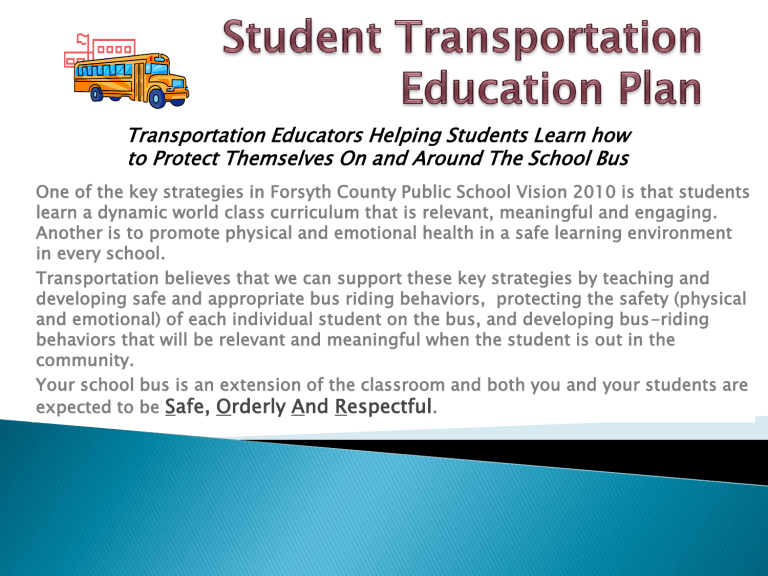Student Transportation Education Plan

Transportation Educators Helping Students Learn how to Protect Themselves On and Around The School Bus
One of the key strategies in Forsyth County Public School Vision 2010 is that students learn a dynamic world class curriculum that is relevant, meaningful and engaging.
Another is to promote physical and emotional health in a safe learning environment in every school.
Transportation believes that we can support these key strategies by teaching and developing safe and appropriate bus riding behaviors, protecting the safety (physical and emotional) of each individual student on the bus, and developing bus-riding behaviors that will be relevant and meaningful when the student is out in the community.
Your school bus is an extension of the classroom and both you and your students are expected to be Safe, Orderly And Respectful .
The Behavior Management Plan is a three-part program that uses steps to help you and your students achieve that goal by developing and maintaining appropriate student behavior while on or near the school bus.
The first steps (prevention and intervention) of the program are administered by you; the school bus driver. The final step of the program
(consequences) are administered by the school administrator or designee.
Prevention steps are used to teach your students how to be Safe, Orderly
And Respectful while waiting at the bus stop and while on the bus.
Let your students know what your expectations are.
Your expectations should be derived from S.O.A.R. fundamentals
Students Learn by Repetition, They Need
Reminders (and second chances.) Explain How and
Why to do What you Expect them to do.
Teach Your Students What S.O.A.R. Means
Know what to do and how to act
Sit the Safe Way
Remain Seated Until Time to Exit the Bus
Keep the Aisle Clear
Use Classroom Voices
Be Respectful to Seatmates
Practice the Emergency Evacuation Every Morning
Remind your students of your expectations
◦ While waiting to unload at the school in the AM.
◦ Practice emergency evacuations every morning by unloading right seat, left seat while explaining what to do in a real emergency.
◦ Stand at your seat, greet each student by name as they board your bus in the afternoon.
Learning each of your students names will show them that you care.
◦ Direct them to go to their assigned seat and talk quietly.
◦ Gain and maintain order while students are loading.
Intervention steps are used by the driver to help create a change in student behavior.
The goal is not to have them suspended from the bus but to assist the student in choosing the Safe, Orderly And Respectful behavior.
Documentation
Verbal Reminder
Seat Reassignment
Talk Privately With Student
Parent Phone Call
Parent Notification Form
Keep a Daily Log
◦ Maintain written documentation in your log book on a daily basis.
◦ Only log the information that will help you remember what happened or what was said.
◦ Document in chronological order.
◦ Document conversations with; students, parents, supervisors and administrators.
◦ Document any student injury such as a fall, nose bleed or a lost tooth, ext…Document and call parent.
◦ Document mechanical issues
◦ Document delays
◦ Document stop sign violations
◦ DOCUMENT, DOCUMENT, DOCUMENT!
Verbal Reminders
◦ Each student on your bus is different; they each have their own personality, their own unique characteristics.
◦ You have to manage each student according to their personality.
◦ If you are reminding a student more than 3 to 4 times in a day then it is time to intervene in a different way.
Seat Reassignment
◦ Does not necessarily mean to the front. Sometimes it is just separating two students who feed off of each others behaviors.
◦ Moving a student to the front shouldn’t be done for a consequence.
◦ Moving a student to front is an opportunity for you to engage with the student and to talk with them about their choices.
Will help you determine what steps can be taken to help the student demonstrate appropriate and safe riding behaviors.
Invite a teacher, lead driver, team leader or your district supervisor on your bus to listen to your conversation.
Parent Phone Call
◦ To invite the parent to partner with you in creating a change in their child's behavior.
◦ Start the conversation by introducing your self.
◦ Then ask the parent to help you create the desired change.
Parent Notification Form
◦ Includes written documentation of the students inappropriate behavior, with all steps taken by you (the driver) documented on the form. The form will be taken home by the students to be signed by a parent and returned to the bus driver within two school days.
◦ Have DS or TL initial the form
◦ Have the student sign the form.
◦ You should keep the district supervisor copy for your records.
◦ If the form is not returned by the second day, you should call the parent.
When to Submit a
Bus Discipline Form
When student behavior escalates beyond the drivers control or the behavior does not improve after using the appropriate intervention steps.
Violations that should be considered major offenses include, but are not limited to the following:
• drugs (includes alcohol, cigarettes, lighters)
• throwing objects off the bus
• fighting (trying to intentionally hurt someone, not pushing or shoving)
• weapons, dangerous instruments, and explosive / implosive devices
• threats/bullying (verbal and physical threats)
• Sexual harassment
Student Behavior
Escalates
Major Offenses
Who, What and How to Submit a Bus Discipline Form
◦ Only include the facts.
◦ Do not include the name of another student.
Include the names of other students on additional reports or on a separate piece of paper clipped to the report.
◦ Submit the report to your supervisor or the supervisor of the school.
Thru a lead driver or team leader.
◦ If the incident takes place on the AM route submit the report before your 1 st tier PM route.
◦ If the incident happens on the PM route submit the report the following morning, after the AM route .
Submitting the report in a timely manner is essential to the administrator investigating the incident.






